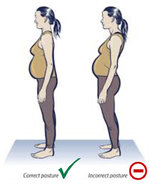Back pain in Pregnancy: It’s normal… or is it?
A woman’s body goes through so many changes during pregnancy that we come to expect some ‘aches and pains’. Most of these discomforts can be directly related to the physical changes that take place during pregnancy, and the resultant changes in our posture and movement patterns.
The growing uterus, with the baby inside, can give rise to experiences of pulling, pressing and pushing, discomfort or pain. Some women describe sharp stabbing pains or deep aching in the pelvis. But when do these ‘normal’ aches and pains become abnormal? And what can I do to get more comfortable?
Often a clear understanding of what is happening and some general advice provides a coping strategy to get through these challenging months. Research shows that more than one-third of women experience back and pelvic pain at some stage during pregnancy. Back and pelvic pain may start at any stage, but for the majority of women it is between the 4th and 7th months. The hormonal preparation for childbirth allows the dense connective tissue to soften resulting in a laxity of the ligaments holding the pelvis and lower back. In addition the weight of the growing fetus causes posture changes with an increased curvature of the lower back tilting the pelvis forward. For many women the back pain is made worse by standing, sitting, forward bending, lifting and twisting. Some describe intense pain in the front of the pelvis, over the pubic bone, and others get pain radiating down the back of the leg as sciatica.
Sleeping Position:
Try to sleep on your side, with a pillow between the knees. Use pillows to support your lower back and your tummy if necessary
Rolling over in bed:
Turn your head to the side, bend your hips and knees, and keeping your legs together roll to the side

Sitting in a chair:
Keep your buttocks well back on the seat, ensure there is a supportive back rest and the feet are fully resting on the floor
Change position frequently

Standing & Walking:
Keep your weight evenly distributed over both feet, with the feet slightly apart. Soften your knees and keep your back upright
Avoid long periods of standing and avoid any heavy lifting

Child Pose –
Keeping your knees apart stretch forward through the back

Pelvic Tilt:
Lying on your back with knees bent, tilt your pelvis to flatten your back into the floor, hold 3 seconds, then relax

Piriformis / Buttock Stretch:
Lying on back, cross one ankle over the other knee. Draw legs up to chest and feel stretch in buttock
Hold 10 seconds

I need more help!
Despite the normal process of hormonal changes during pregnancy, it is not acceptable to be told “What do you expect, you are pregnant, you can’t expect relief until the baby is born’. Once the physiotherapist assesses you and comes to a diagnosis there are many ways to relieve the pain and provide additional support to the pelvis during the remainder of the pregnancy.
While relaxation of the pelvic girdle is normal in all pregnancies some women experience far more severe symptoms than others. If the discomfort and pain are interfering with normal everyday activities it is advised you have a physiotherapy assessment.